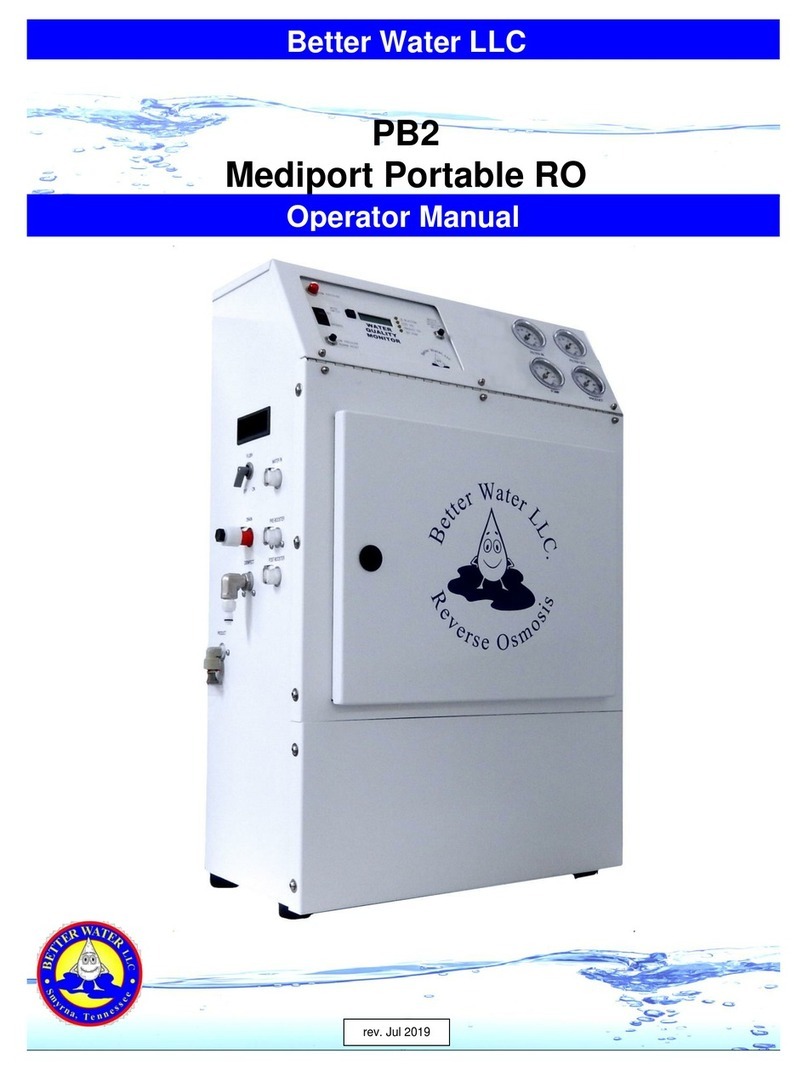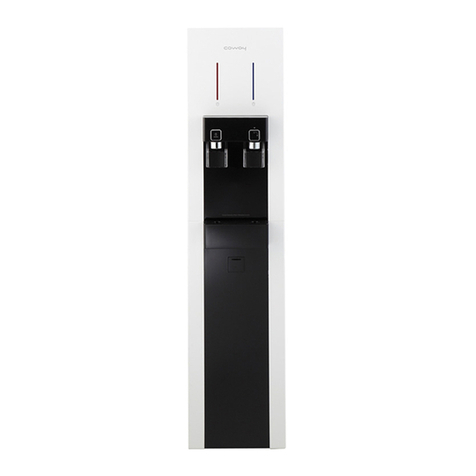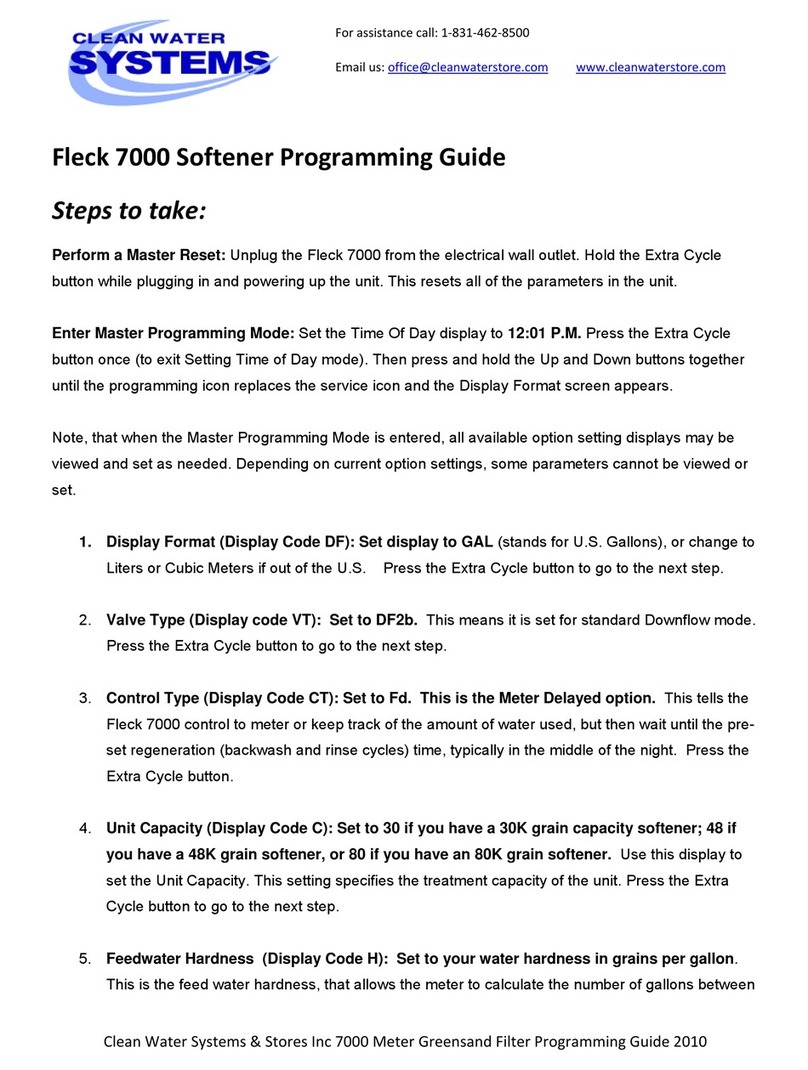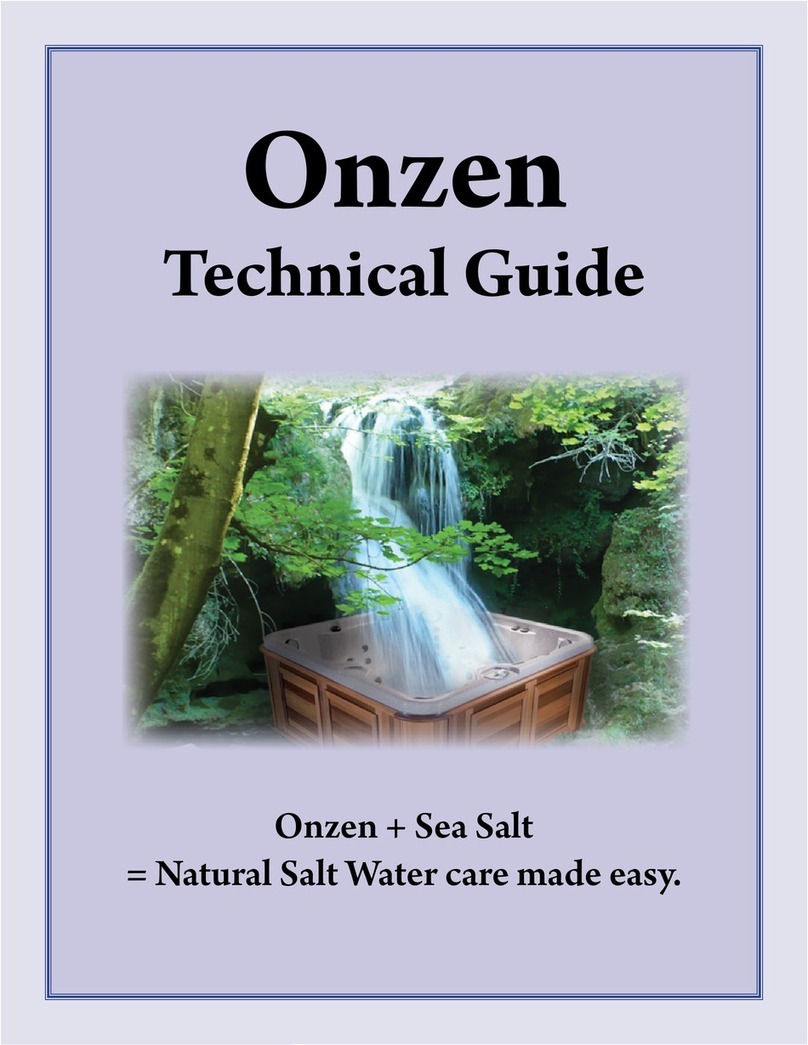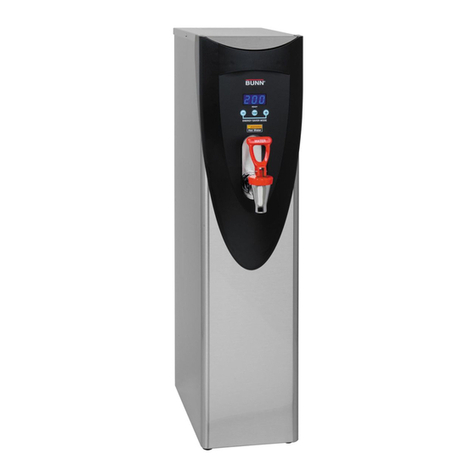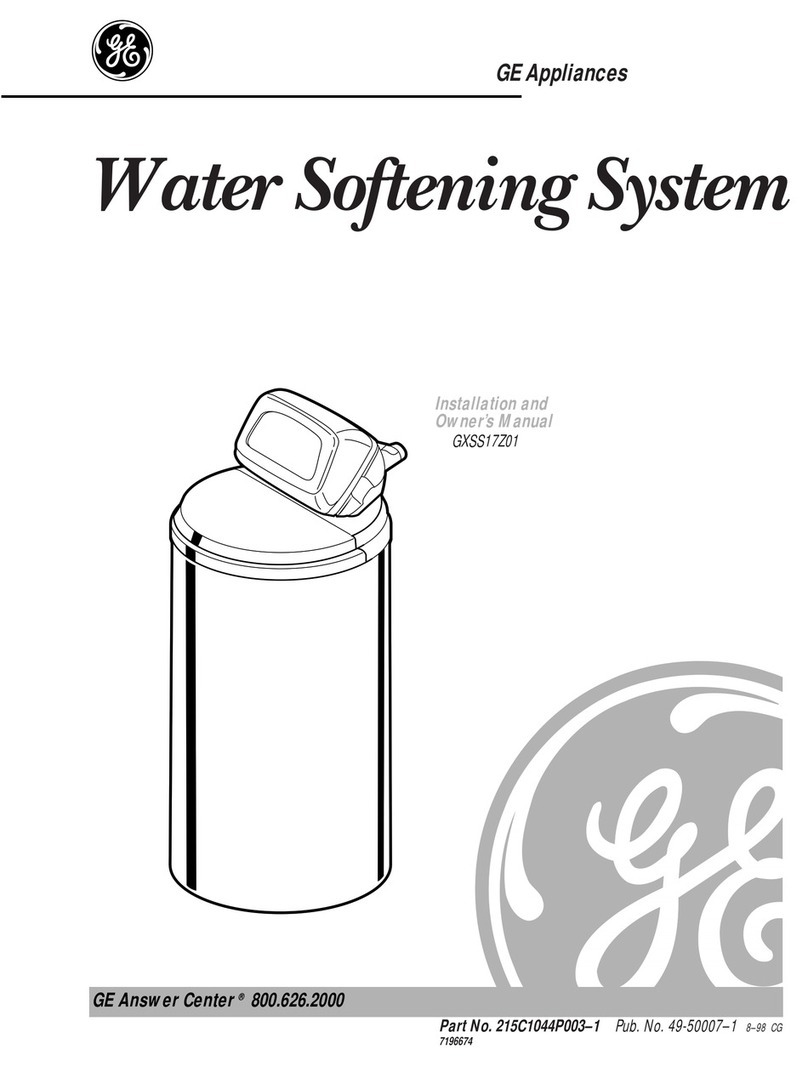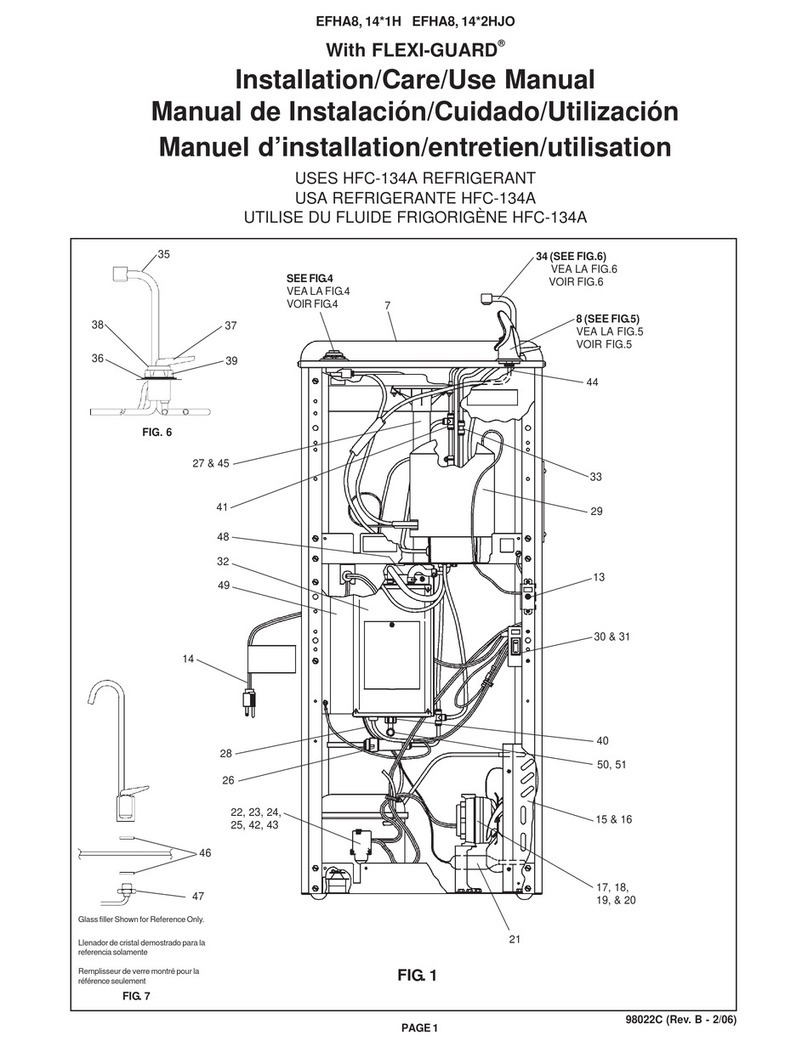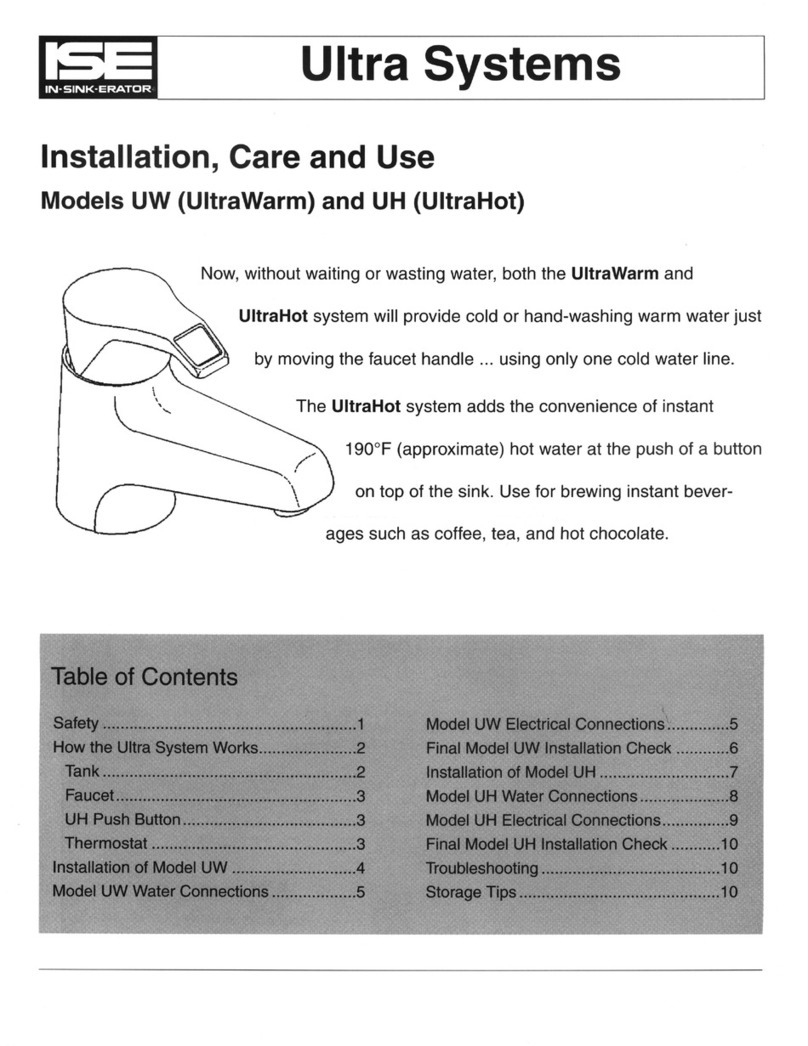EURAQUA Duplex Series Instruction manual

9000/9100/9500 Duplex Series
9xDXIOMM\page 1
Installation
Operation
Maintenance
Manual
Duplex Nitrate Removal
With 9000/9100/9500 Series
Downflow Brining Valve
20-350 litres Resin
Inc. Measuring Tank Option
Models:
Mechanical Meter/Timer
SXT Electronic Meter/Timer

9000/9100/9500 Duplex Watersoftener
Installation Operation Maintenance Manual
9xDXIOMM\page 2
CONTENTS
NOS. PAGE
1.0 GENERAL NOTES 5
2.0 THE SOFTENING PROCESS 6
2.1 In Service 6
2.2 Regeneration 6
2.3 The Regeneration Process 7
2.4 Meter Control of Regeneration Initiation 7
2.5 Duplex Operation 8
3.0 UNPACKING AND PARTS IDENTIFICATION 9
3.1 Basic Packages 9
3.2 Unpacking Notes 9
3.3 Missing or Damaged Goods 9
4.0 TEMPORARY STORAGE 9
5.0 DESCRIPTION OF PLANT COMPONENTS 10
5.1 Nitrate Removal Vessel and Internals 10
5.2 Control Valve 10
5.3 Regeneration Controller and Transformer 10
5.4 Brine System 11
6.0 PRE-INSTALLATION CHECKS 12
6.1 Mechanical 12
6.1.1 Foundations/Drainage 12
6.1.2 Operating Space 12
6.1.3 Incoming Water 12
6.1.4 Pipework 13
6.1.5 Water Supply Company Requirements 13
6.2 Electrical 13

9000/9100/9500 Duplex Watersoftener
Installation Operation Maintenance Manual
9xDXIOMM\page 3
NOS. PAGE
7.0 ASSEMBLY/INSTALLATION 14
7.1 Mechanical 14
7.1.1 Assembling Vessel, Riser Tube and Internals 14
7.1.2 Charging the Resin 14
7.1.4 Assembling the Control Valve 15
7.1.5 Attatching the Control Valve and Slave Adapter 15
7.1.6 Brine System 15
7.1.7 Pipework 15
7.1.8 Storage tank ball valve 16
7.1.9 Drains and Overflow Connections 16
7.2 Electrical 17
7.2.1 Mains Supply 17
7.2.2 Transformer 17
8.0 COMMISSIONING 18
8.1 Introduction 18
8.2 Controller Setting 18
8.2.1 Setting the Time of Day 18
8.2.2 Site Program –Setting the Capacity 18
8.3 Brine System 19
8.3.1 Brine Tank Filling 19
8.4 Pre Service Flush and Regeneration (MI) 20
8.5 Pre Service Flush and Regeneration (SXT) 22

9000/9100/9500 Duplex Watersoftener
Installation Operation Maintenance Manual
9xDXIOMM\page 4
NOS. PAGE
9.0 OPERATION 23
9.1 Normal Operation 23
9.2 Refilling with Salt 23
9.3 Manual Regeneration 23
9.4 By-passing the Nitrate Removal 23
9.5 Temporary Shut-down 24
9.6 Changes in Incoming Water 24
9.7 Routine Monitoring 25
10.0 FAULT FINDING AND RECTIFICATION 26
10.1 No Flow to Service 26
10.2 Poor Treated Water Quality 26
10.3 No Regeneration 27
10.4 Unsatisfactory Capacity between Regeneration’s 27
11.0 WARRANTY AND SERVICE 28
11.1 After Sale Warranty 28
12.0 TECHNICAL DATA 29
12.1 Process and Operating 29
12.2 Engineering Data 34
13.0 FACTORY PROGRAMMING
13.1 Regeneration Settings 39
13.2 Nitrate Removal Outputs 40
13.3 Master Programming Setup Summary 9000/9100 41
13.3 Master Programming Setup Summary 9500 43
14.0 DRAWINGS
14.1 Dimensions 45
14.2 General Installation 46
15.0 CE CERTIFICATE 48
APPENDIX I
Resin MSDS
APPENDIX II
Valve manufacturer's manual including parts lists and exploded diagrams

9000/9100/9500 Duplex Watersoftener
Installation Operation Maintenance Manual
9xDXIOMM\page 5
1.0 GENERAL NOTES
These instructions cover the 9000/9100/9500 Range of Duplex Water
Softeners, which includes models ranging in size from 20-120 litres resin
volume fitter with ¾” – 1.1/2” Mechanical Meter/Timer or SXT Electronic
Meter/Timer.
It is recommended that these instructions are read throughout before
commencing any work on the unit, particularly if you have no previous
experience of installing and using a water Nitrate Removal.
The installation of a Nitrate Removal is very straightforwards, and the only
adjustments to be made to the controller program are setting the water
hardness as detailed in Section 8. However we have tried to make these
instructions as comprehensive as possible to answer any queries you may
have about the functioning of your Nitrate Removal.
This Nitrate Removal will require salt for regeneration. We recommend the
used of proprietary 'pellet' or 'tablet' salt.
Drinking softened water has not been shown to be harmful to normal healthy
children and adults, but softened water contains a higher level of Sodium
than a hard town mains supply. This is of concern to individuals on low
Sodium diets or for babies fed with powder formula milk that already contains
Sodium. It is therefore recommended that a separate un-softened drinking
water supply is left in place or installed on a drinking water faucet. If a
cartridge type water filter is installed on the drinking water line, this must be
fed with un-softened water.
We have also supplied with the system the original valve manufacturer's
handbook. This is written principally for American customers and has a
number of small differences in the setting up instructions from those used in
Europe. In the event of confusion, refer to the data in this manual rather
than in the valve manufacturer's handbook!

9000/9100/9500 Duplex Watersoftener
Installation Operation Maintenance Manual
9xDXIOMM\page 6
2.0 THE SOFTENING PROCESS
Hardness in water is caused by the presence of dissolved salts of Calcium
and Magnesium. In order to overcome the problems associated with the use
of hard water, these salts must be removed. This process is called
'Softening'. One means of removing the salts is to exchange them for
soluble Sodium salts. This technique is known as 'Ion Exchange Softening'.
2.1 IN SERVICE
In order to soften the water, it is passed through a bed of Ion Exchange resin
beads which are contained inside a vertical cylindrical vessel. these beads
are made of a synthetic material, and are usually amber or dark brown in
colour and between 0.5 and 1.0 mm in diameter.
As the water flows down through the resin, the Calcium and Magnesium in
the hard water are progressively exchanged for Sodium, with the result that
the water which flows out of the unit contains only Sodium salts, which are
not scale-forming. The Calcium and Magnesium remain, attached to the
resin.
The Ion Exchange resin does not have an unlimited capacity for exchanging
Calcium and Magnesium, so to keep the exit water soft it is necessary to
periodically 'Regenerate' the resin to restore its capacity to soften the water.
2.2 REGENERATION
The softening process can be reversed if a strong solution of Sodium
Chloride (i.e. Common salt dissolved in water -'brine') is passed through the
resin.
The high concentration of Sodium allows it to exchange for the Calcium and
Magnesium held on the resin, and these are then carried away to drain. The
resin is left full of Sodium to enable it to soften water again.

9000/9100/9500 Duplex Watersoftener
Installation Operation Maintenance Manual
9xDXIOMM\page 7
2.3 THE REGENERATION PROCESS
The regeneration process consists of four stages:-
Backwash - Water flows upwards through the resin bed, and out to a drain.
As it does so, it loosens the ion exchange beads, removes any resin 'fines'
(i.e. small pieces of broken beads etc.) and cleans off any particles of dirt or
pipework corrosion products which may have accumulated during the service
cycle.
Brine injection/Displacement Rinse - During the first part of this stage, the
concentrated salt -solution is drawn from the salt storage tank, blended with
water to reduce the concentration to the correct level, and passed down
through the resin. When the required quantity of brine has been drawn in,
the water flows alone to push the remaining brine through the resin at the
correct rate, and ensure that all the resin sees the right amount of
regenerant.
Fast Rinse - This follows the brine injection and displacement rinse stage,
and entails rinsing away the residual brine and Calcium and Magnesium salts
from the resin and re-packing the resin bed down. This is done down with
water flowing through the resin in the direction of service.
Salt Tank Refill - Following the fast rinse, a quantity of water sufficient to
dissolve the correct amount of salt for the next regeneration is returned to the
salt tank. When this has finished, the unit automatically returns to service.
2.4 METER CONTROL OF REGENERATION INITIATION
A water meter is installed in the outlet from the Nitrate Removal, to measure
the volume of water which passes to service. This meter drives a turbine, the
movement of which is measured by a magnetic sensor which sends signals
to the regeneration controller. The controller microprocessor uses this
information to calculate when the unit should be regenerated.

9000/9100/9500 Duplex Watersoftener
Installation Operation Maintenance Manual
9xDXIOMM\page 8
2.5 DUPLEX OPERATION
A 'Duplex' system is a means of operation to achieve a constant flow of soft
water to service, without the need for extensive treated water storage.
The system is essentially two vessels, which are connected to common inlet
and outlet pipework, and which are in service alternately. Both vessels are
served by a single valve/controller mounted on one of the vessels. This
diverts water to the appropriate tank for treatment or regeneration. One
vessel will be in service at any one time, the other being in its regeneration
cycle, or regenerated and on stand by, ready to enter service.
The vessel in service will operate until the integral water meter reaches its
pre-set volume. At this stage, the stand-by vessel is switched into
service, and the vessel which had been in service enters its regeneration
cycle. At the end of regeneration, this vessel goes into stand by, and waits
for the vessel now in service to complete its pre- set volume, at which point
the vessels swap over again, and the whole cycle starts again.

9000/9100/9500 Duplex Watersoftener
Installation Operation Maintenance Manual
9xDXIOMM\page 9
3.0 UNPACKING AND PARTS IDENTIFICATION
3.1 BASIC PACKAGES
The Nitrate Removal will be delivered in a number of packages which include
a pair of glassfibre reinforced pressure vessels, a control valve, slave valve
adapter, interconnecting hoses, a brine tank, an even number of 25 litre bags
of resin with possibly two additional part bags, and a funnel to fill the vessels.
The 20 litre system wil be supplied with just two 20 litre bags of resin.
3.2 UNPACKING NOTES
The unpacking of the Nitrate Removal is quite straightforward, and there are
no 'hidden' items. It is advisable to keep the packages sealed until such time
as they are used, to prevent dust or water entry.
Care should be taken in lifting the Nitrate Removal or its parts out of their
cartons. It is advisable to lay large cartons on their side and slide out the
Nitrate Removal or parts prior to standing them up.
3.3 MISSING OR DAMAGED GOODS
Immediately on receipt of the goods, it is advisable to check that all items
ordered have been received. If you have any doubt that goods have been
supplied as requested, please contact your supplier immediately. If any
items are missing or damaged, the carrier and your supplier must be notified
in writing within 3 days of receipt if a claim is to be made.
4.0 TEMPORARY STORAGE
If installation is not to start immediately after delivery, the equipment should
be stored in a clean dry area, where it will not be damaged, or be subjected
to temperatures below freezing.

9000/9100/9500 Duplex Watersoftener
Installation Operation Maintenance Manual
9xDXIOMM\page 10
5.0 DESCRIPTION OF PLANT COMPONENTS
5.1 NITRATE REMOVAL VESSEL AND INTERNALS
The pressure vessel which contains the ion exchange resin is made from a
fibreglass/epoxy resin outer layer surrounding an inner, seamless shell made from
Polyethylene, Polypropylene or ABS. Vessels below 80 litre resin capacity have a
threaded hole at the top, of 2.5 inch nominal diameter, into which the control valve
fits. Vessels for 100 litres of resin or more have larger 4 inch nominal diameter
hole and an adapter is supplied to reduce the hole to the 2.5 thread on the valve fro
use with 9000 and 9100 valves. The 9500 valve can only be used with 4 inch hole
vessels.
All vessels are equipped with a distribution system. This is attached to a central
riser tube, which is connected to the control valve, and passes water into and out of
the resin bed. On smaller systems this will have a single distributor fitted to the
riser. On larger and high flow systems there will be multiple distributors built up as a
‘hub and laterals’ on the bottom of the riser tube.
5.2 CONTROL VALVE
The control valve is mounted on top of one vessel, and directs the water flow in and
out of the resin beds during the service and regeneration cycles. A manifold
assembly or 'slave valve adapter' is mounted on top of vessel No. 2. This is then
connected to the main control valve via a pair of braided hoses (9000), plastic
interconnect pipes (9100) or copper tubes (9500). The body of the control valve is
a brass casting (9000 & 9500) or injection moulded polymer (9100), containing
operating parts made from Teflon and synthetic rubber.
The valve carries out its various functions by moving pistons backwards and
forwards in a series of seals and spacers contained within the body casting. The
movement of these pistons is controlled by a rotating cam, which is driven from the
controller. Further cams in the controller direct the movement of the valve
controlling the brine system.
5.3 REGENERATION CONTROLLER AND TRANSFORMER
The regeneration controller is attached to the valve, and is contained in a plastic
housing.
The controller is powered by 24v AC electricity, and a separate, wall mounted
transformer is connected to the valve to reduce normal mains voltage down from
240v so that all the electrical supply in and around the control valve runs at a safe
24v.

9000/9100/9500 Duplex Watersoftener
Installation Operation Maintenance Manual
9xDXIOMM\page 11
5.4 BRINE SYSTEM
The brine system consists of a moulded polyethylene tank into which the
brine well and brine pick up are assembled. The tank forms the salt storage
container.
The brine pick-up tube within the brine well is connected to the pipe from the
control valve which sucks the brine from the tank. At the bottom of the brine
pick-up tube is an air check valve. This serves to prevent air entering the
valve when all the brine has been drawn in. Air in the system could cause
spurting and 'hammering' at the taps or outlets.
BRINE MEASURING SYSTEM
The Brine Measuring System consists of a measuring tank, brine high level
float, brine solenoid and brine pick up. These needs to be fed from a Salt
Storage Tank with fully saturated brine solution.
The brine pick-up tube within the brine well is connected to the pipe from the
control valve which sucks the brine from the tank. At the bottom of the brine
pick-up tube is an air check valve. This serves to prevent air entering the
valve when all the brine has been drawn in. Air in the system could cause
spurting and 'hammering' at the taps or outlets.

9000/9100/9500 Duplex Watersoftener
Installation Operation Maintenance Manual
9xDXIOMM\page 12
6.0 PRE-INSTALLATION
6.1 MECHANICAL
6.1.1 Foundation/Drainage
The Nitrate Removal will not require any special foundations, provided that a
firm, level area which is capable of supporting the working weight is
available. (See Engineering Data, Section 12.2)
Unwanted water from the regeneration process must flow to drain, and so an
open drain or gully, capable of passing the necessary flow is required (see
Process and Operating Data, 12.1, for relevant flows). The total flow of water
to drain depends on site conditions, but will be approximately 6 times the
resin volume. The drain may be at a level no higher than 500mm above the
Nitrate Removal valve.
A second drain is required for the brine tank overflow. This is a safety drain
which will only discharge water if there is a malfunction in the control valve.
Where possible this should be installed through an outside wall like a cistern
overflow, where it will give a visual indication of any failure.
6.1.2 Operating Space
The space occupied by the Nitrate Removal can be found in the Engineering
Data (Section 12.2).,
Access will be required to refill the brine tank, and to carry out adjustments or
maintenance on the equipment. It is therefore recommended that a
minimum of 500mm clearance be allowed in front of the unit for this purpose.
6.1.3 Incoming Water
The raw water to be fed to the Nitrate Removal must comply with the
following:-
1. Available at all times at a flow equal to the required service flow or
greater, and
2. At a pressure between 1.7 and 5.5 bar
3. Temperature between 0 and 50oC
4. Suspended solids less than 1 ppm
5. Iron less than 0.2 ppm, Manganese less than 0.1 ppm, Free Chlorine
less than 1 ppm if temperature is less than 15oC, less than 0.3 ppm if
temperature higher (up to 30oC)

9000/9100/9500 Duplex Watersoftener
Installation Operation Maintenance Manual
9xDXIOMM\page 13
6.1.4 Pipework
Pipework to be connected to the Nitrate Removal should not have an
excessive amount of hardness scale deposit. Piping that is heavily built up
with scale (or Iron deposits) should be replaced.
Make sure that the pipework can be connected to the Nitrate Removal in
such a way as to impose no stresses on the control valve, and that it is
properly aligned and supported.
A system for the complete by-passing and isolation of the Nitrate Removal
should be installed (see Section 7.1.6).
6.1.5 Water Supply Company Requirements
It is essential that if the equipment is to be connected directly to a mains
water supply, the local bylaws must be adhered to. These cover both
plumbing and the prevention of backflow into the mains. If there is any
doubt, the local water inspector should be consulted, but in general, the
installation of a 'Double check valve assembly' conforming to BS6282 part 2
will be required in the feed pipework to the Nitrate Removal.
If the pressure available from the mains is not adequate it will be necessary
to install a booster pump arrangement. Such a system would be covered by
additional bylaws, and the water storage tank needed must comply with
these.
6.2 ELECTRICAL
A continuous supply of 24v, 5 VA is required by the Nitrate Removal. A 240v
transformer with an output of 9.6 VA (70 VA if Brine Measuring System used)
is provided, which should be connected to an uninterrupted mains supply,
which is separately 1 Amp fused, and does not have any additional switch.
It is recommended that the transformer be attached to a nearby wall, within
500 mm of the Nitrate Removal in an area free from water spray or excessive
heat or condensation.
A plug is not provided with this Nitrate Removal since the cable should be
connected to fused spur outlet. However if that is not possible then a plug
should be fitted to the cable with a 1 amp fuse. The socket used should be
un-switched to prevent the Nitrate Removal from being inadvertently turned
off.

9000/9100/9500 Duplex Watersoftener
Installation Operation Maintenance Manual
9xDXIOMM\page 14
7.0 ASSEMBLY/INSTALLATION
7.1 MECHANICAL
Check all the items against the parts list and shipping documents, and
ensure you have them all before starting work. In addition to the Nitrate
Removal you will require installation materials and basic tools, (i.e.,
spanners, screwdrivers etc., and PTFE tape)
7.1.1 Assembling Vessel, Riser Tube and Internals
The larger units are shipped as pre-assembled components to reduce the
risk of transit damage. These need to be assembled on site. Open the
cartons containing the pressure vessels and remove them. Check that the
vessels have not been damaged in transit. Pay particular attention to the
vessel's top hole threads, as this is where the valve will seal. Check that
there is no dirt or swarf inside.
Riser Tube/Bottom Filter
This comprises a length of pipe (the 'riser tube') to one end of which is
bonded a moulded screen or hub and lateral. The other end is fitted into the
bottom of the control valve. To make sure the riser fits properly, and there is
no leakage, it will be supplied to the correct length prior to despatch.
7.1.2 Charging the Resin
The ion exchange resin is supplied in 25 litre bags and/or part bags if
applicable - half for each vessel. All models will be supplied with exactly the
right quantity of resin. It is important that only the correct volume of resin is
put into each vessel or the system will not function properly. (See Section
12.1.2 for data)
Place the vessel in its final location - once filled with resin and water they
should not be moved. Fill the vessel about 1/5 –1/3 full with clean water. A
cover is provided to be slipped over the end of the riser when filling with
resin. This must be carefully removed without disturbing the riser prior to
fitting the control valve. Carefully open the resin bags and pour the resin into
the vessel, using a funnel, keeping the riser tube central and upright. Take
great care not to spill resin on the floor. If any is spilt, make sure it is swept
up immediately, as it is very easy to slip on it. Wash away any loose resin
from the threads of the vessel or adapter collar. Remove the riser cover and
check that the top of the riser is still correctly located

9000/9100/9500 Duplex Watersoftener
Installation Operation Maintenance Manual
9xDXIOMM\page 15
7.1.4 Assembling the Control Valve
Carefully remove the control valve and the slave tank adapter from their
packing, and check that all parts are present. On the 9000 and 9100 valves,
snap in the bayonet fit distributors to the control valve and slave tank
adapter.
7.1.5 Attaching the Control Valve and Slave Adapter
Carefully fit the control valve on to the right hand vessel, taking care to
ensure that the riser tube locates correctly into the valve base through the
top distributor, and that the threads are not crossed. Also take care to make
sure that the 'O' rings are properly seated and not pinched. Repeat the
process to fit the slave adapter. Connect the two vessels together using the
braided flexible hoses using the swivel coupling end on the slave adapter.
The vessel with the slave adapter must be connected to the left hand side of
the control valve.
Install a suitable service flow controller to the outlet connection of the control
valve if the treated water is to be supplied in to a storage tank at the same
level as the system. This will ensure that there is sufficient back pressure for
regeneration of the standby vessel.
7.1.6. Brine System
Move brine tank into position and connect the outer port of the bulk head
union to the brine draw connection on the valve using the 3/8" or ½” tubing.
Make sure that this connection is also tight to stop air leaking in.
If the brine draw tubing is adjusted for length during installation, ensure that
brass tubing inserts are refitted into tubing end prior to connecting into brine
tank and control valve.
7.1.7 Pipework
Pipework should be assembled incorporating the features shown in the
Installation Diagram, Section 14.1. It is essential that inlet and outlet isolating
valves and a by-pass valve are provided, and that the water main is
protected by a double check valve where appropriate (see Local Water Bye-
laws).
In domestic premises it is recommended that a hard water supply is still used
for drinking water (see General Notes Section 1.0).
Pipework can be constructed from any normally acceptable material (Copper,
Galvanised, Plastic), provided it is properly supported and aligned. Ensure
that the pipe is sufficiently large to accommodate the flow of water required,

9000/9100/9500 Duplex Watersoftener
Installation Operation Maintenance Manual
9xDXIOMM\page 16
making due allowance for the pressure drop between the Nitrate Removal
and the point of discharge of soft water.
NOTE: IF BRAZED OR SOLDERED FITTINGS ARE TO BE USED, THE
PIPEWORK MUST BE DISCONNECTED FROM THE VALVE DURING
HEATING AND COOLING. EXCESS HEAT CAN CAUSE PERMANENT
DAMAGE TO SOME OF THE VALVE COMPONENTS.
The inlet and outlet pipework should be connected to the horizontal, right
facing connections on the right of the valve manifold (1" BSP Female) (see
Fig 1 in Section 14.1).
7.1.8 Storage tank ball valve
Conventional ball float valves pass water at a slow trickle into storage tanks
and cisterns when they are shutting off. Trickle flow is not recommended for
satisfactory functioning of a water Nitrate Removal since channelling can
occur through the resin bed and the meter may not accurately monitor very
low flows. It is therefore recommended that main storage tanks for softened
water should have the ball valve replaced with a servo type valve such as a
Torbeck, Fluidmaster or Aylesbury which permit full flow until they close off.
These are inexpensive and are a direct replacement for the more common
brass ball float valves.
7.1.9 Drains and overflow connections
Connect the overflow fitting on the brine tank to a suitable drain, using
flexible or rigid tubing. Make sure that there is a clear gap of approximately
50 mm between the end of the tube and the top of the drain tundish or gully
edge.
The drain connection from the valve is a 1/2" hose spigot (9000 & 9100) or
¾” BSPF threaded socket (9500). Flexible tube should be run from this
connection to a drain capable of taking the maximum flow in regeneration
(see Section 12.1), and leaving a similar gap above the drain edge. The
drain must not be at a higher level than the 500mm above the control valve
and preferably should have an air break at the same height as the control
valve.

9000/9100/9500 Duplex Watersoftener
Installation Operation Maintenance Manual
9xDXIOMM\page 17
7.2 ELECTRICAL
Electrical installation is very straightforward, but should still be carried out by
a competent electrician, and must conform to the appropriate standards of
safety.
7.2.1 Mains Supply
The mains supply should be through a separate, switched supply, fused and
earthed in accordance with Institute of Electrical Engineers Regulations.
Current rating should be 1 Amp.
7.2.2 Transformer
A safety transformer is provided to reduce the voltage to 24 Volts to operate
the controls.
This should be attached to a convenient wall, within 500mm of the Nitrate
Removal. DO NOT SWITCH ON THE ELECTRICAL SUPPLY AT THIS
STAGE
The transformer supply should be connected with the brown cable to the live
(fused) terminal in the supply outlet and the blue cable to the neutral
terminal. The transformer is double insulated and does not require an earth
connection.

9000/9100/9500 Duplex Watersoftener
Installation Operation Maintenance Manual
9xDXIOMM\page 18
8.0 COMMISSIONING
8.1 INTRODUCTION
It is recommended that the commissioning of the plant is undertaken by a
trained service engineer, who will be able to put the plant into service quickly,
and most efficiently. However, if the services of an experienced engineer are
not available, following the steps outlined below will result in the system
being properly commissioned.
8.2 CONTROLLER SETTING - Site programming mode
All SXT controller settings will require the valve to have a mains supply
switched on. The valve must not be regenerating when controller settings
are adjusted.
8.2.1 Setting the Time of Day
There is no requirement on the Mechanical Initiation valves to set the time of
day
On SXT timers the display alternates between the time of day, the remaining
calculated capacity in litres before regeneration and the vessel on line (U1 or
U2). Wait until the time of day is displayed and the press the up ? and down
? arrow keys until the correct time of day is displayed.
8.2.2 Site programming - Setting the capacity and regeneration override.
The Nitrate Removal regeneration cycles have been factory programmed.
The volume capacity of the resin in litres has also been set up based on a
default hardness of 21 Degrees Clark (300ppm). This may need to be
altered based on local water hardness (see section 13.2).
There is no regeneration override facility on the Mechanical Initiation valves.
On SXT valves, a regeneration override is used to freshen the resin if a
regeneration has not taken place for a number of days.
Press and hold the press the up ? and down ? arrow keys together for 5
seconds. The volume capacity of the resin in litres will be displayed. This
can be adjusted to suit site conditions by pressing the up and down arrows.

9000/9100/9500 Duplex Watersoftener
Installation Operation Maintenance Manual
9xDXIOMM\page 19
Press the extra cycle button to set the regeneration override. The default is 3
days for duplex softeners. This may be changed to a different interval by
pressing the up and down arrows.
Press the extra cycle button to exit the Site Programming mode.
8.3 BRINE SYSTEM
8.3.1 Brine Tank Filling
Place approximately 100 mm depth of water in the bottom of the brine tank.
Fill with pellet salt (recommended) until the brine tank it is full or with granular
salt until it is 3/4 full.
Overfilling the brine tank with granular salt can result in an overflow of brine.
This cannot happen with pellet salt, which is why it is recommended.
Under no circumstances use cooking salt or Pure Vacuum Dried (PVD) salt
to fill the brine tank as either of these will damage the resin and the internal
components of the regeneration valve and brine draw system.
8.3.2 Brine Measuring System Filling
Connect the solenoid inlet to the outlet of the Salt saturator (3/4” solvent
weld) ensure the middle of the two high level floats (mounted side by side) is
set at the a height above the brine pick up shut off position corresponding to
the following table.
RESIN QUANTITY
(LITRES)
QUANTITY OF BRINE ABOVE PICK UP
(LITRES)
20
8
25
12
50
19
75
34
100
37
120
46
150
61
190
76
200
76
250
106
300
121
350
137

9000/9100/9500 Duplex Watersoftener
Installation Operation Maintenance Manual
9xDXIOMM\page 20
8.4 PRE-SERVICE FLUSH AND REGENERATION –MECHANICAL TIMERS
Set the manual isolating valves so that water will by-pass the Nitrate
Removal. Turn on the main water supply. Open a soft water tap close by
and let the water run for a few minutes to flush out any debris or foreign
matter from the pipework system.
Turn on the power supply to the valve.
Remove the dust cover from the control valve and ensure that the meter
cable is not plugged into the meter on outlet of the valve. Swing 'open' the
timer assembly on the left of the valve by pulling on its right hand edge. Turn
the manual regeneration knob on the front of the timer clockwise until the first
row of pins on the program wheel on the back of the timer lifts the outer
microswitch.
Turn on the power supply. The drive motor on the right of the control valve
will run and will start to slowly drive the internal gearing. The bottom shaft
will move first, followed by the top shaft. When both shafts and all the gears
have finished moving the valve is in the backwash position of the
regeneration cycle. This will take several minutes. Turn off the power
supply.
Slowly open the water inlet valve. Air will be expelled from the drain line,
followed by water once the vessels are filled with water. Open the inlet valve
fully to allow water to run to drain for 4-5 minutes.
Turn on the power supply and index the regeneration knob to the 'brine'
position - the microswitch is in the first (long) gap in the bank of pins.
Water/brine will be drawn in from the brine tank, and water will trickle slowly
down the drain line.
When the gears have stopped moving, index to the rapid rinse section -
second bank of pins - and again wait for the gears to stop moving. Water will
run quickly down the drain line.
Index the knob to the brine refill section - second (short) gap in the pins - and
wait for the gears to stop moving. Water will be refilled into the brine tank.
Finally, index the knob to the 'home' position past the last pair of pins (inner
microswitch drops into the indent in program wheel) and wait for the gears to
stop moving. This has commissioned one vessel.
Leave the power supply on and repeat the sequence in 5) above to
commission the second vessel. However after indexing the knob to the brine
position (iii) leave the timer to drive the program wheel round until the final
pair of pins have lifted the microswitch. This will ensure that the correct
This manual suits for next models
3
Table of contents
Popular Water Dispenser manuals by other brands

Whirlpool
Whirlpool WDAB600XWX Use & care guide

US Water Systems
US Water Systems Ultimate Dual Superfilter FSF-250 owner's manual

Sentencia
Sentencia Volumo Installation & operating instructions

WaterLogic
WaterLogic 4 Firewall user manual
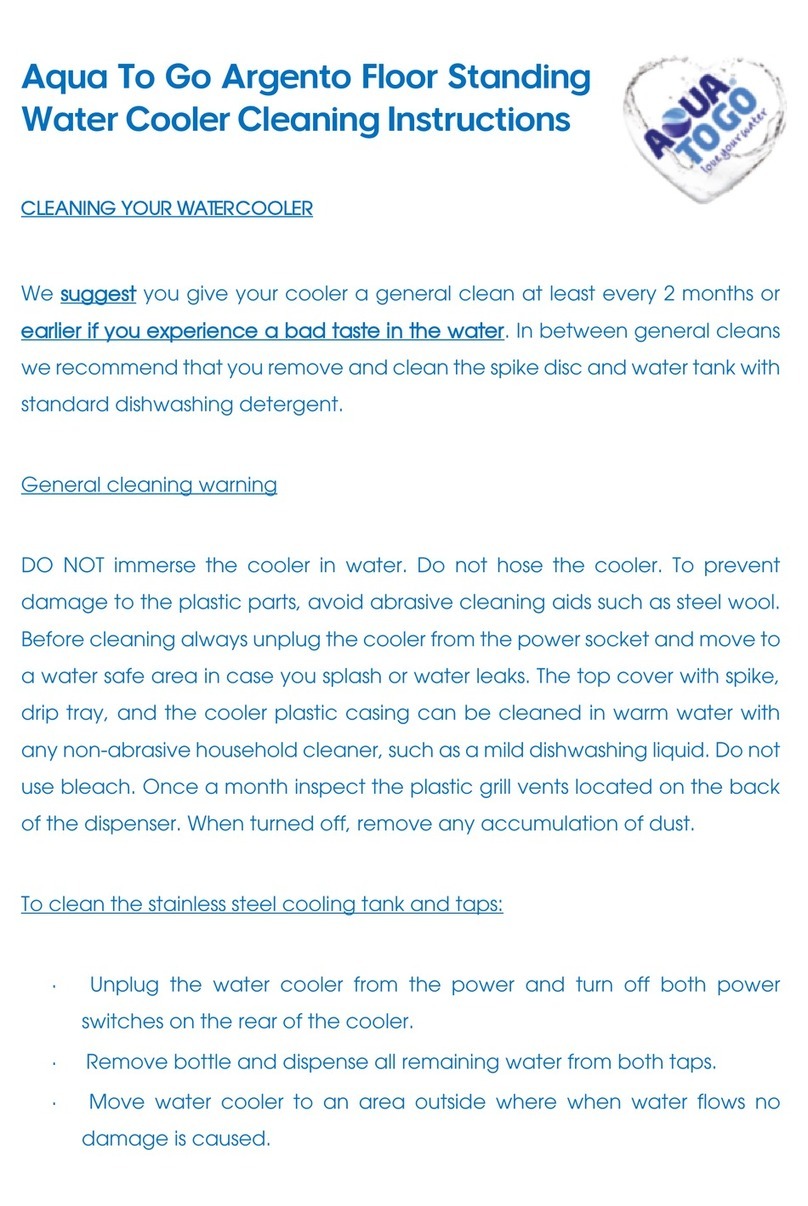
Aqua To Go
Aqua To Go Argento Cleaning instructions
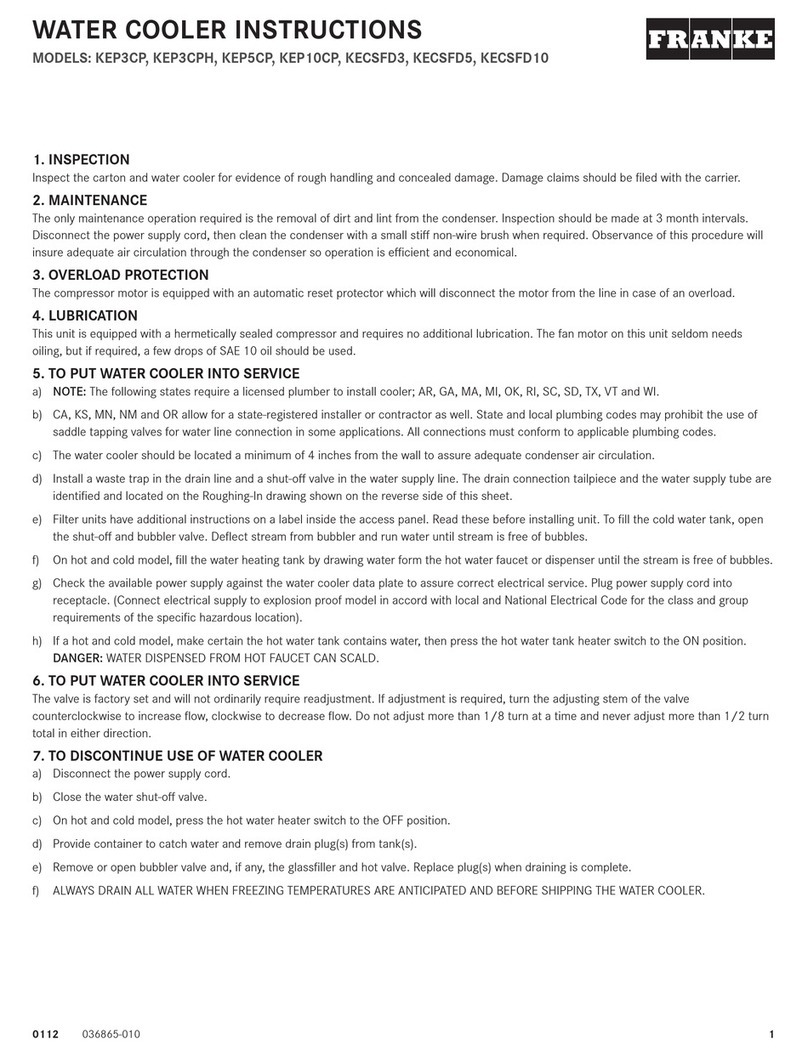
Franke
Franke KEP3CP instructions
